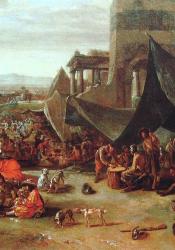Sack of Rome
Waged by the army of the Holy Roman Emperor, the conquest of Rome on May 6, 1527 came after a long-term power struggle between the Roman Empire under Charles III and the Papacy under Pope Clement VII, who had allied himself with several Western European powers. Comprised of Spanish and German mercenaries, the Imperial army attacked the much smaller militia force of the Papal states, besieging the poorly defended Roman city in just over a day. Though the Imperial army suffered the loss of Emperor Charles III, who died in the initial assault, they succeeded in reaffirming dominion over the Papacy in Rome. As a display of their power over Papal affairs, the victorious Imperial troops continued to ransack the city for months, desecrating churches and monasteries, and torturing Roman citizens. Ultimately, though the sack of Rome itself was brief, the belief that the moral failures of the Church were to blame for Rome’s fall—the belief that there was a need for Papal reformation—pervaded much of Western Europe for many years to come.
(Image Source: Johannes Lingelbach [Public Domain], via Wikimedia Commons, https://commons.wikimedia.org/w/index.php?curid=6632076)

